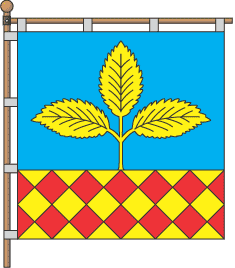 (1:1)
(1:1)from the site of Ukrainian Heraldry

Last modified: 2005-03-12 by dov gutterman
Keywords: berestechko | volyinia |
Links: FOTW homepage |
search |
disclaimer and copyright |
write us |
mirrors
 (1:1)
(1:1)
from the site of Ukrainian
Heraldry
See also:
From the site of Ukrainian
Heraldry:
"It was confirmed at June, 22d, 2001 by the decision N13/2
of city council. The rectangular canvas with a ratio of the sides
1:1. Panel consists of two horizontal fields - top dark blue
(width in 2/3 parties of a flag) in which sprouts yellow
birkenrinde with three leaflets, and bottom, chequy in the
soltire by yellow and red fields. The author is A.Grechylo."
Dov Gutterman, 20 February 2005
lc-be.gif)
from the site of Ukrainian
Heraldry
From the site of Ukrainian
Heraldry:
"It was confirmed at June, 22d, 2001 by the decision N13/2
of city council.
Board per fess abaised. Azure, or birkenrinde (berest) with three
leaflets; chequy in the soltire by gules and or. The shield
enframed by or cartouche and crowned by argent urban crown with
three prongs. The author is A.Grechylo.
Birkenrinde specifies one of versions about an origin of the city
name from birke woods. Chess division personifies a battlefield,
blood on the sandy. Symbols specify revival of city after
tragical events. Azure means goodwill and nobleness, and also
waters of small river Styr.
A.Grechylo, "Ukrainian city and village arms and
flags", part 1."
Dov Gutterman, 20 February 2005
from the site of Ukrainian
Heraldry
"The first mention refers to XV century. The Magdeburg Right
was given at July, 7th, 1547.
Near the city in the 1651 was a well-known drama fight of Bohdan
Khmel'nyts'kyi troops against the Polish armies. When the cossack
army already began to win, the Crimean khan Islam-Girey III who
was bribed by Poles, has betraid het'man and, having taken away
him in a captivity, has run away from a battlefield. The cossack
army remained without a management.
On emergency advice colonels have decided to stop fight and to
recede through bogs. For covering a withdrawal of the troops have
been left some small groups. The eyewitness of fight Frenchman
Pierre Shevale so described end of this fight: "In one place
among a bog has gathered three hundred cossacks and bravely
battled against the big number of attacking. Completely
surrounded, they were lost. There was one which struggled during
three hours against all Polish army."
Peasants dug out the weapon, crania, bones of cossacks and Poles
through 100, and in 200 years after fight. For last 20 years it
is found about hundred human skeletons, many exemplary of the
weapon and personal things.
Different sources submit the quantity of armies which took part
in fight. The most possible figures - about 150 000 Poles against
100 000 cossacks. On the party Khmel'nyts'kyi was about 30 000
Tatars.
Till now it is not known, whether plot of Tatars with Poles was.
Khmel'nyts'kyi, having learned about change, has rushed after for
Tatars, and itself was taken as prisoner. And though fight last
ten more days after it, his destiny has been solved.
In territory of a museum is wooden Mykhailivs'ka church from
Ostriv village (transferred in 1914), constructed even before
fight. Before an iconostasis - a ladder under the ground. The
underground course conducts to a sarcophagus with remains of
cossacks.
An ornament of a museum . Heorgiivs'ka church. Analogues of
church in the world are not present, as in one walls are three
temples: Heorgiivs'ka - the basic, Borys and Glib church is on
the second floor and Paraskeva Pyatnycia church - underground.
The project of a temple-monument was developed by the student of
architectural branch of the Academy of arts in Petersburg
V.Maksimov. Any construction was not capable to contain all
praying. It has been overcome due to the unexpected decision - to
bear an iconostasis outside. The church appeared directly under
the sky.
For 2 kilometers from a complex is the island of Haiok surrounded
with bogs. Legendary 300 cossacks here have found death. All the
day some thousand Poles could not overcome them. Even downs
appeared powerless. While fight last, Poles could not be risen to
a ferry, and thousand cossacks and peasants could recede easy. To
storm island has arrived king Jan Kazimir. And in the evening
groups of German mercenaries have grasped island.
Now here, behind a crosswise fence are some old crosses. Last
from three hundred cossacks has left here. Having come up on the
middle of lake a boat, the last cossack was shot from enemies.
Struck with his heroism, Polish king has suggested the cossack to
surrender in a captivity, having promised to leave a life. The
cossack has refused and was lost not defeated. In the body of the
unknown hero have found 14 bullets.
Field of fight in 30th years of ХХ century, in days of the
Polish occupation, was the forbidden place for which visiting it
was possible to get in prison. At the Soviet authority here was
pioneer camp. Only in 1966 the territory has been declared by
reserve and transferred to a museum."
Dov Gutterman, 20 February 2005